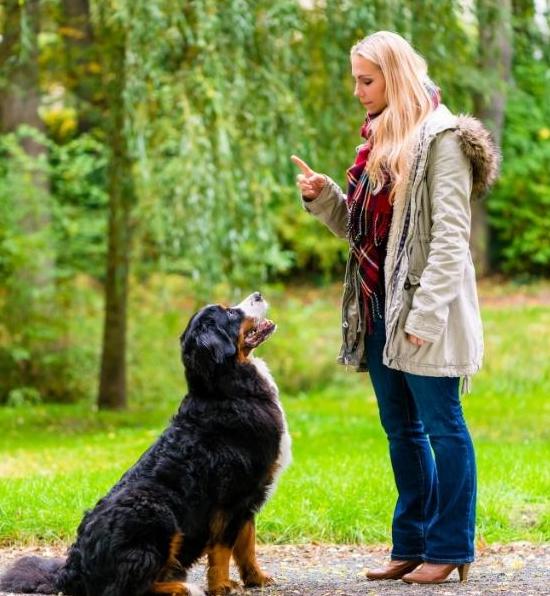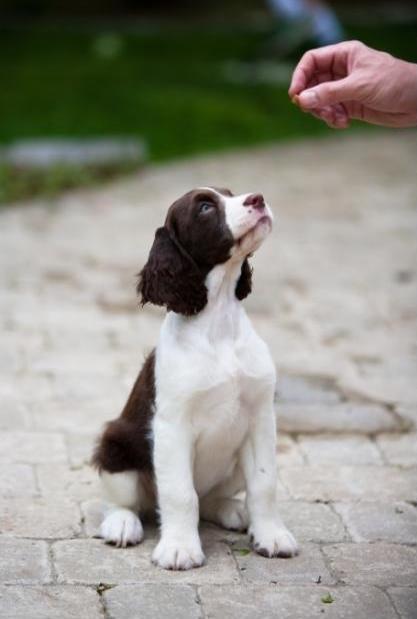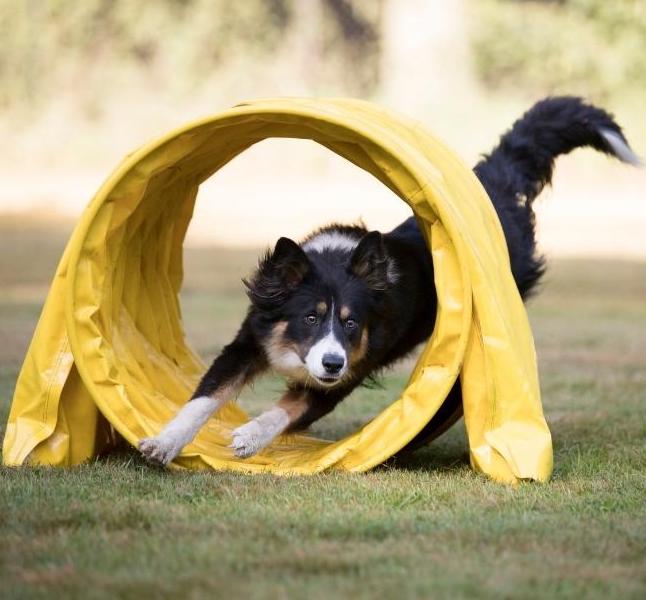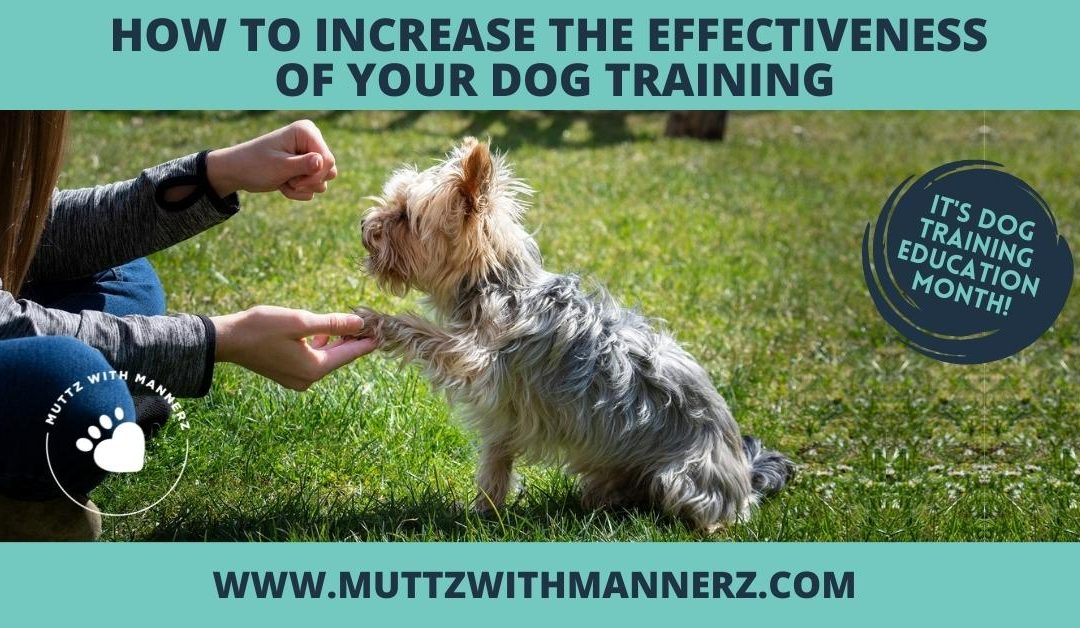It’s dog training education month and as canine educators, we are passionate about pups!
We feel it is important for every owner to understand how they can positively contribute to the success of their dog training efforts. From providing clear communication, creating a consistent, positive training environment to understanding the stages your dog will go through in its lifetime, the following information can help you to increase the effectiveness of your dog training journey!
Provide Clear Communication
Dogs communicate differently than us. They have a voice, barking and they use canine communication which has a lot to do with their body language. When teaching them it’s important to understand this and provide clear communication so they understand what is expected of them.
 A couple of key things to consider to ensure you are being clear and consistent during the training process are:
A couple of key things to consider to ensure you are being clear and consistent during the training process are:
Your Body Language – Body language and how you are positioned play a role in how your dog listens. If you are sitting down that is a very relaxed position and your dog may not take you seriously. Your body language should be engaging. If you are using hand signals in addition to commands this can help provide a visual especially if you have increased the distance between you and your dog while training.
Your Tone of Voice – When commands or markers are given your voice should be more enthusiastic and upbeat versus your usual talking voice.
Recognize the Impact of your Energy
Something owners don’t often consider is how their energy can impact a training session. Dogs are highly aware and sense how people are feeling. If you are tired, sick, fatigued, or angry this is not the time to train your dog.
Pick training times when you are feeling good, enthusiastic, and motivated to teach your dog a new trick or skill! Creating a positive training experience is key to helping your dog learn – plus you keep it fun for you!
The Stages of Dog Training
Being aware of what stage of training your dog is in will contribute to your success. This knowledge allows you to be patient with your pup and provide them the encouragement and reinforcement to be successful. It can also help you and your training provider know the best class for them to try! We strongly encourage you to be patient and take your time to lock in the learning before you go to the next step. Going too fast can create confusion with your pup. There are 3 stages of training that we refer to and we’d like to review them.
Stage 1: The Teaching Stage
In Stage 1 your dog doesn’t know what you expect of them or understand verbal commands; you are teaching them to learn the behaviour. The goal at this stage is to teach the desired behaviours you want by starting with a lure to assist. The lure can be a yummy treat or favourite toy.
 The lure helps generate excitement which motivates them to do the behaviour such as a sit or down. In addition to the lure, you would mark the behaviour to let them know they got it right. A verbal “yes” or a clicker can be used as a marker. The timing of the marker is important. It should be timed exactly at the point when the dog achieves what you want.
The lure helps generate excitement which motivates them to do the behaviour such as a sit or down. In addition to the lure, you would mark the behaviour to let them know they got it right. A verbal “yes” or a clicker can be used as a marker. The timing of the marker is important. It should be timed exactly at the point when the dog achieves what you want.
For example, you are teaching the sit and you lure the dog into that position. You would mark the moment when their butt touches the ground. Once they have done the desired behaviour a couple of times you can add the verbal command and hand signals.
Once your dog understands what is expected you can increase the attention span and add some low distractions. This stage can take anywhere from 1 – 3 weeks before they understand what is expected but wait until they gain the reliability needed before moving them on to the next stage.
When your dog can perform commands quickly and reliably around a variety of distractions with minimal problem solving required, then your dog and you are ready to move on to stage two. During the first stage, reward your dog every time using food or a toy followed by praise such as “good dog”.
Stage 2: Proof and Reinforcement Stage
In Stage 2 you are building a commitment and bond with your dog so that they want to perform and please you. The use of a lure is removed as the dog understands what is expected and knows the verbal command and possibly the hand signal if you have introduced one. Rewards can be given in this stage but intermittently.
This stage will last between 2 – 6 weeks on average. Some situations will require you to stick with this stage for longer than average.
This is the stage where you can introduce a correction phrase if your dog doesn’t perform what is asked and you know that they do understand the command. Ask yourself – “Am I being consistent with how I’m asking for the command?” If the answer is “yes” then a positive correction word can be introduced. Our favourite phrases are “Oops” or “Ah ah” in a different tone of voice. A negative or forceful correction is not required. (Some examples of negative correction are harshly saying “bad dog” or forcing them to the ground or swatting them.)
Avoid rushing to the next stage – take your time and enjoy the process! It is common that dogs mature and age and can revert to the Teaching Stage again. It all depends on your dog as they do not fully mature until 2 ½ – 3 years old.
Before you move to Stage 3 the goal is that your dog can perform what is asked and has learned how to filter out distractions entirely.
 Stage 3: The Maintenance Stage
Stage 3: The Maintenance Stage
The third and final stage of training your dog is the Maintenance Stage, and this stage is ongoing for the life of your dog. During this stage, your dog knows what is expected and can perform on command, consistently. Boundaries and structure are in place and your dog has routines i.e. walks, feeding, sitting when greeting people, etc. Rewards are still given but on your schedule. Your role is to maintain the level of obedience you’ve taught them.
This is where the fun can continue!
Build on what you have taught by adding new tricks or commands. Attend one of our fun classes like Fun with Agility or Scent Training which builds on the skills your dog has learned.
These classes are not only fun, but without ongoing training and reinforcement, it’s easy for a dog to regress and start unwanted behaviour.
Training should be fun for both you and your dog. Taking the time to effectively train them and go clearly and patiently through all the stages will develop your pup into a well-mannered, balanced dog you can be proud of.
At Muttz with Mannerz we welcome you and your pup at any stage and offer classes and services to help you engage your dog throughout their life. Visit muttzwithmannerz.com/classes to register today!

